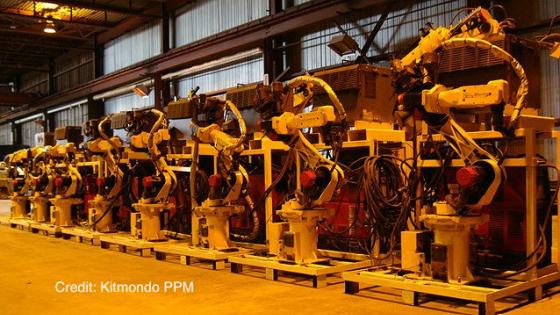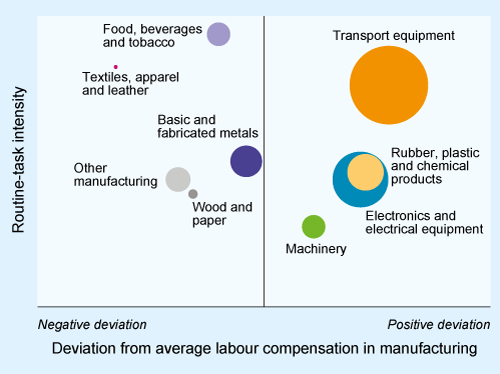The digital revolution, and particularly the rapid march of robot technology, is making people more anxious. This anxiety is rooted in the perceived threat of robots to upturn the world of work because they are exponentially getting smarter and more autonomous. Most of the current debate on robots focuses on developed countries (e.g. Acemoglu and Restrepo 2017, Arntz et al. 2016, Dauth et al. 2017, Graetz and Michaels 2017), but robotisation clearly also concerns developing countries. By some accounts, the risk of job displacement through robotisation is particularly high in developing countries (World Bank 2016, Chang et al. 2016).
From a development perspective, the big question is whether robots will reduce the familiar benefits of industrialisation as a development strategy. This will be the case if robot-based automation makes industrialisation more difficult or causes it to yield substantially less manufacturing employment than in the past. Should such expectations turn into reality, the commitment to inclusive prosperity of the 2030 Agenda for Sustainable Development will be technologically subverted before it gets off the ground.
Robots and industrialisation
Industrial robots are machines that can be programmed to perform production-related tasks without the need for a human controller. This greater autonomy causes industrial robots to dramatically increase the scope for replacing human labour compared to conventional types of machines. Rapid technological change has reduced the price of industrial robots (Graetz and Michaels 2017), as reflected, for example, in the reduction of the global price of capital goods relative to that of consumer goods by some 25% between 1975 and 2012 (Karabarbounis and Neiman 2014). Unsurprisingly, robots use has grown dramatically, especially since 2010 when the global stock of operational industrial robots increased by over 50% to reach 1.6 million in 2015 (International Federation of Robotics 2016).
Assessments of the employment impact of robots have generally been based on a task-based approach, which hypothesises that a job is composed of different tasks and that new technology does not always favour better-skilled workers but often complements workers in certain tasks of their job, while substituting for them in others (Autor et al. 2003). This approach distinguishes between manual, routine, and abstract tasks. While many occupations involve a combination of tasks and different manual and routine tasks have been mechanised for centuries, new technologies, including robots, predominantly substitute labour in routine tasks. These are those that can be clearly defined and follow pre-specified patterns, so that they can be coded and translated into the software.
One way of operationalising the task-based approach and determining the technical feasibility of automation is through routine-task intensity indices, which link routine tasks to occupations that workers perform on their jobs (Autor and Dorn 2013, Marcolin et al. 2016). Such indices indicate that routine-based tasks dominate in manufacturing.
Studies indicating robots' dramatic job displacement potential (e.g. Frey et al. 2016) generally emphasise this technical feasibility of workplace automation. New research from UNCTAD (2017) argues that these studies' exclusive focus on the technical feasibility of job displacement make them overestimate the potential adverse effects of robots, and especially so for developing countries. These studies neglect to take into account that what is technically feasible is not always also economically profitable.
Figure 1 links robot use in manufacturing on the one hand, and technical feasibility and economic profitability of robot-based automation on the other. The vertical axis reflects the technical feasibility of robot-based automation, based on a routine task intensity index for specific manufacturing sectors (Marcolin et al. 2016). It suggests that the technical feasibility of job displacement in manufacturing is highest in food, beverages and tobacco, followed by the textiles, apparel and footwear sector. The horizontal axis reflects the economic profitability of robot-based automation in manufacturing, based on sector-specific labour compensation (calculated from the Conference Board database). It suggests that job displacement by robots is more profitable in relatively skill-intensive and well-paying manufacturing, such as the automotive and electronics sectors, than in relatively labour-intensive and low-paying sectors, such as apparel. The sizes of the bubbles reflect the sectoral distribution of actual global robot stocks in 2015 (based on International Federation of Robotics, 2016).
Taken together, the figure shows that robots are concentrated in those manufacturing sectors that are on the right-hand side of the figure, rather than at its top. This suggests that economic factors are more important for robot deployment than the technical possibilities of automating workers’ tasks. However, both technical and economic feasibility appear to be important: the bubble with the largest size, transport equipment, is also the topmost of the four sectors on the right-hand side of the figure; and the bubble sizes increase along the upper right quadrant, as routine task intensity and unit labour costs both increase. The figure also suggests that robot deployment has remained very limited in those manufacturing sectors where labour compensation is low, even if these sectors have high values on the routine task intensity index. Robot deployment in the textiles, apparel and leather sector has been lowest among all manufacturing sectors even though this sector ranks second in terms of the technical feasibility of automating workers’ routine tasks.
Figure 1 Proximate relationship between technical and economic feasibility of routine task automation, and estimated stock of industrial robots, by manufacturing sector
Source: Figure 3.6 in UNCTAD (2017).
Evidence that routine tasks tend to prevail in manufacturing and that robots tend to be used in relatively skill-intensive and well-paying manufacturing can be used to assess which countries are currently most exposed to robot-based automation. Figure 2 suggests that on current technological and economic indicators, developed countries and developing countries other than least-developed countries (LDCs) are exposed to robot-based automation in manufacturing to a larger extent than LDCs. It should be noted that this evidence only refers to exposure to robot-based automation and does not take account of the risks to employment from other forms of automation. But it suggests that robot-based automation per se does not invalidate the traditional role of industrialisation as a development strategy for lower income countries. Yet, the dominance of robot use in sectors higher up on the skill ladder implies greater difficulty for latecomers in attaining sectoral upgrading and may limit their scope for industrialisation to low-wage and less dynamic (in terms of productivity growth) manufacturing sectors. This could seriously stifle these countries’ economic catch-up and leave them with stagnant productivity and per capita income growth.
Figure 2 Proximate current vulnerability to robot-based automation in manufacturing, selected economies
Source: Figure 3.7 in UNCTAD (2017).
Industrial upgrading could also become more difficult because it is in those countries in which global manufacturing has become concentrated (Wood 2017) where robot deployment dominates: almost half of the operational robots are in Germany, Japan, and the US; China has quadrupled its robot stock since 2010; and the Republic of Korea has the highest number of robots per worker globally.
It should also be noted that some of the adverse employment and income effects that intelligent machines could create may well occur in countries that do not use robots. Robots boost companies' international cost competitiveness, which may in turn spur exports and thereby make other countries bear at least part of the adverse consequences from robot-based automation through reduced output and employment opportunities. Evidence for Germany and for Mexico's auto industry shows that these countries' increased use of robots has been accompanied by productivity and employment gains, but also by a growing export surplus in the most robot-intensive sectors (UNCTAD 2017: Table 3.4).
Moreover, a key element in the distribution of gains from technological change is the return provided to those controlling the knowledge and the machines in which it is embodied. In the case of robot-based automation, the countries and firms that produce robots and those that own the intellectual property embodied in them will benefit from robotics more than other countries and firms. The little evidence that is available (UNCTAD 2017: 46) suggests strong geographic concentration of these returns – mainly in Japan, the Republic of Korea and Germany, as well as probably the US for which, however, no specific data are available.
Conclusion
Robots are not yet suitable for a range of labour-intensive industries, leaving the door open for developing countries to enter industrialisation processes along traditional lines. Developing countries should embrace the digital revolution, including by (1) creating the managerial and labour skills needed to operate new technologies and widely diffuse the benefits of their use; and (2) establishing internet links between massive data storage and the computing devices that power the increased use of robots. And all countries need appropriate regulatory frameworks to avoid a few taking most of the benefits, including when creating digitisation-based new products and new jobs.
Any industrialisation strategy will benefit from stable but expansionary global economic conditions driven by sustained productive investment and supported by broad-based global income growth. Such an environment is currently absent. In this sense, the novelty of industrial robots lies not only in their greater scope and faster speed of automation alone, but also in its occurrence at a time of subdued macroeconomic dynamism. This tends to hold back the investment needed for the new technology to create new sectors and absorb displaced workers and, hence, to bring about the benefits that have characterised earlier technological breakthroughs.
References
Acemoglu, D and P Restrepo (2017) “Robots and jobs: Evidence from the US”, VoxEU.org, 10 April.
Arntz, M, T Gregory and U Zierahn (2016), “The Risk of Automation for Jobs in OECD Countries,” OECD Social, Employment and Migration Working Papers, No. 189.
Autor, D H and D Dorn (2013), "The growth of low-skill service jobs and the polarization of the US labor market", American Economic Review 103 (5): 1553–1597.
Autor, D H, F Levy and R J Murnane (2003) “The Skill Content of Recent Technological Change: An Empirical Exploration,” Quarterly Journal of Economics 118(4): 1279–1333.
Chang, J H, G Rynhart and P Huynh (2016), "ASEAN in transformation. How technology is changing jobs and enterprises", Bureau for Employers’ Activities, Working Paper No.10, International Labour Office.
Dauth, W, S Findeisen, J Suedekum and N Woessner (2017), “German robots – The impact of industrial robots on workers”, CEPR Discussion Paper 12306.
Frey, C B, M Osborne and C Holmes (2016), "Technology at Work v2.0. The Future is Not What it Used to Be", Oxford Martin School and Citi Global Prospects and Solutions.
Graetz G and G Michaels (2017), “Robots at work”, CEP Discussion Paper 1335.
International Federation of Robotics (2016), World Robotics 2016: Industrial Robots, Frankfurt am Main.
Karabarbounis L and B Neiman (2014), "The global decline of the labor share", Quarterly Journal of Economics 129 (1): 61–108.
Marcolin L, S Miroudot and M Squicciarini (2016), "The routine content of occupations: new cross-country measures based on PIAAC", OECD Trade Policy Papers No. 188.
UNCTAD (2017), "Robots, industrialization and inclusive growth", chapter 3 in Trade and Development Report 2017.
Wood A (2017), “Variation in structural change around the World, 1985-2015: Patterns, causes, and implications”, WIDER Working Paper 2017/34.
World Bank (2016), "Digital Dividends", World Development Report 2016, Washington DC.





